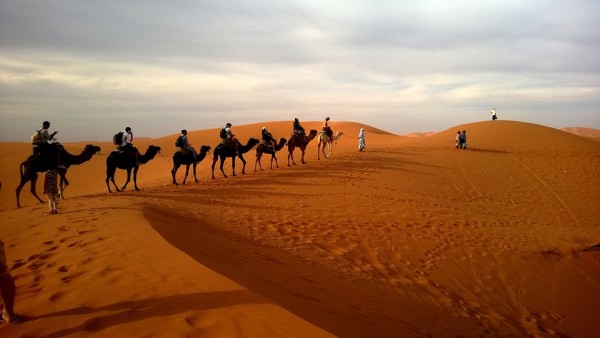Camel DNA Shaped by Ancient Human Trade Routes
| Ana Verayo | | May 11, 2016 07:02 AM EDT |
(Photo : Pixabay) Human trade routes beginning 3,000 years ago shaped the genetic evolution of camels.
A new study reveals how the genetic diversity of camels is shaped by ancient trade routes, as this animal has been a crucial part of humankind's evolutionary migration. Scientists examined and analyzed DNA samples from the Arabian dromedary camel, from more than 1,000 camels possessing the single, iconic hump.
Like Us on Facebook
Even if camel populations span a distance of hundreds of miles from each other, they are all still very similar in genetic composition. Scientists also believe that this cross continental trade routes caused genetic "blurring" among the camels.
According to Olivier Hanotte from the Nottingham University, the biological evolution and history of the humble dromedary is also fascinating as it provides clues about human history as well. By analyzing the dromedaries, they can provide a glimpse of human history as they have also moved with people through trade.
Researchers found this distinct signature and then comparing this with DNA samples that contains genetic data, across populations within the camel's range. Hanotte says that with the help from an international team, samples were obtained from Oman, Pakistan, Syria nad West Africa.
The dromedary became a domesticated animal 3,000 years ago, to carry around large and heavy goods across Africa and Asia. Trade caravans consisted of thousands of these camels that would have provided transportation across the deserts of North Africa and the Arabian Peninsula.
Hanotte explains that people in the early 20th century travel hundreds of miles with camels, as the creatures carry all their important goods. Upon reaching the Mediterranean, the animals naturally arrive extremely exhausted. Those animals would be left there where they will be replenished with new animals for the return journey.
This trend produced genetic "shuffling", that caused the dromedaries to be located in entirely separate continents, but still genetically similar to each other. Genetic diversity among the camels involves mixing up the population, which means that they are more adaptable to extreme changes in environment and weather.
This new study about the evolution of camel genetics is published in the Proceedings of the National Academy of Sciences.
TagsCamels, dromedary camel, ancient migration routes, camel DNA evolution, Human evolution, Genetics
©2015 Chinatopix All rights reserved. Do not reproduce without permission
EDITOR'S PICKS
-

Did the Trump administration just announce plans for a trade war with ‘hostile’ China and Russia?
-

US Senate passes Taiwan travel bill slammed by China
-

As Yan Sihong’s family grieves, here are other Chinese students who went missing abroad. Some have never been found
-

Beijing blasts Western critics who ‘smear China’ with the term sharp power
-

China Envoy Seeks to Defuse Tensions With U.S. as a Trade War Brews
-

Singapore's Deputy PM Provides Bitcoin Vote of Confidence Amid China's Blanket Bans
-

China warns investors over risks in overseas virtual currency trading
-

Chinese government most trustworthy: survey
-

Kashima Antlers On Course For Back-To-Back Titles
MOST POPULAR
LATEST NEWS
Zhou Yongkang: China's Former Security Chief Sentenced to Life in Prison

China's former Chief of the Ministry of Public Security, Zhou Yongkang, has been given a life sentence after he was found guilty of abusing his office, bribery and deliberately ... Full Article
TRENDING STORY

China Pork Prices Expected to Stabilize As The Supplies Recover

Elephone P9000 Smartphone is now on Sale on Amazon India

There's a Big Chance Cliffhangers Won't Still Be Resolved When Grey's Anatomy Season 13 Returns

Supreme Court Ruled on Samsung vs Apple Dispute for Patent Infringement

Microsoft Surface Pro 5 Rumors and Release Date: What is the Latest?










